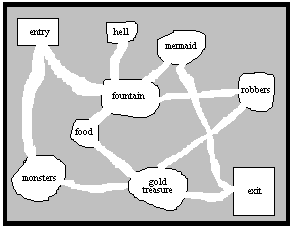You're
an adventurer, and you've heard that there is a vast gold treasure hidden
inside a cave. Many people before you have tried to find it, but to no avail.
The cave is a labyrinth of galleries connecting different rooms in which there
are dangerous beings, like monsters and robbers. In your favor is the fact that
the treasure is all in one room. Which route should you follow to get to the
treasure and escape unhurt with it? Consider the following map of the cave:

Figure 16.2: The Labyrinth of Galleries
You can construct a Visual Prolog representation of the map to help you find a safe
route. Each gallery is described by a fact. The predicates go and route
give rules. Give the program the goal
go(entry, exit).
The answer will consist of a list of the rooms
you should visit to capture the treasure and return safely with it.
An important design feature of this program is
that the rooms already visited are collected in a catalog. This happens thanks
to the route predicate, which is defined recursively. If you're
standing in the exit room, the third parameter in the route predicate will be a
list of the rooms you've already visited. If the gold_treasure room is a member of this list, you'll have achieved
your aim. Otherwise, the list of rooms visited is enlarged with Nextroom, provided Nextroom is not one of the dangerous rooms and has not been visited
before.
/* Program ch16e03.pro */
DOMAINS
room = symbol
roomlist = room*
PREDICATES
nondeterm gallery(room,room)
% There is a gallery between two rooms
% Necessary because it does not matter
% which direction you go along a gallery
nondeterm neighborroom(room,room)
avoid(roomlist)
nondeterm
go(room,room)
nondeterm route(room,room,roomlist)
% This is the route to be followed.
% roomlist consists of a list of rooms
already visited.
nondeterm member(room,roomlist)
CLAUSES
gallery(entry,monsters). gallery(entry,fountain).
gallery(fountain,hell). gallery(fountain,food).
gallery(exit,gold_treasure). gallery(fountain,mermaid).
gallery(robbers,gold_treasure). gallery(fountain,robbers).
gallery(food,gold_treasure). gallery(mermaid,exit).
gallery(monsters,gold_treasure). gallery(gold_treasure,exit).
neighborroom(X,Y):-gallery(X,Y).
neighborroom(X,Y):-gallery(Y,X).
avoid([monsters,robbers]).
go(Here,There):-route(Here,There,[Here]).
route(Room,Room,VisitedRooms):-
member(gold_treasure,VisitedRooms),
write(VisitedRooms),nl.
route(Room,Way_out,VisitedRooms):-
neighborroom(Room,Nextroom),
avoid(DangerousRooms),
not(member(NextRoom,DangerousRooms)),
not(member(NextRoom,VisitedRooms)),
route(NextRoom,Way_out,[NextRoom|VisitedRooms]).
member(X,[X|_]).
member(X,[_|H]):-member (X,H).
After verifying that the program does find a
solution to the goal
go(entry, exit).
you might want to try adding some more
galleries, for example,
gallery(mermaid, gold_treasure).
Or you can add some additional nasty things to
avoid.
Even though--once you've made these
additions--there is more than one possible solution to the problem, your
program will only come up with one solution. To obtain all the solutions, you
must make Visual Prolog backtrack as
soon as it has found one solution. You can do this by adding the fail
predicate to the first rule for route:
route(Room, Room, VisitedRooms) :-
member(gold_treasure, VisitedRooms),
write(VisitedRooms), nl, fail.
To get a neater output, you could use a
list-writing predicate, write_a_list, to write the list of names without the containing square brackets ([
and ]) or the separating commas. However, the rooms you've visited are
collected in the VisitedRooms list in
reverse order (exit first and entry last). Therefore, you need to
reverse the list or make the list-writing predicate write the list in reverse.
